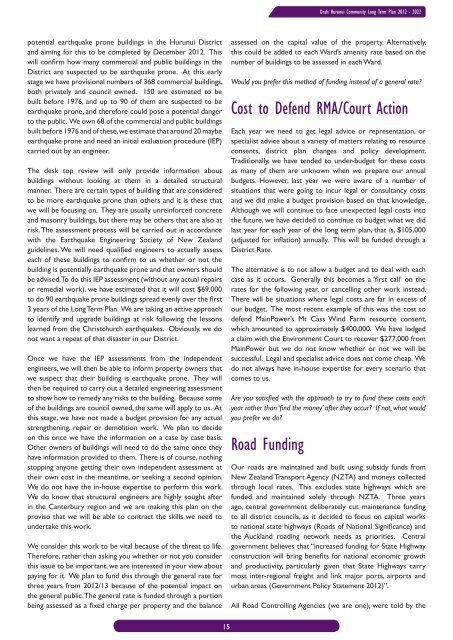DRAFT LTP book.indb - Hurunui District Council
DRAFT LTP book.indb - Hurunui District Council
DRAFT LTP book.indb - Hurunui District Council
Create successful ePaper yourself
Turn your PDF publications into a flip-book with our unique Google optimized e-Paper software.
Draft <strong>Hurunui</strong> Community Long Term Plan 2012 - 2022potential earthquake prone buildings in the <strong>Hurunui</strong> <strong>District</strong>and aiming for this to be completed by December 2012. Thiswill confi rm how many commercial and public buildings in the<strong>District</strong> are suspected to be earthquake prone. At this earlystage we have provisional numbers of 368 commercial buildings,both privately and council owned. 150 are estimated to bebuilt before 1976, and up to 90 of them are suspected to beearthquake prone, and therefore could pose a potential dangerto the public. We own 68 of the commercial and public buildingsbuilt before 1976 and of these, we estimate that around 20 maybeearthquake prone and need an initial evaluation procedure (IEP)carried out by an engineer.The desk top review will only provide information aboutbuildings without looking at them in a detailed structuralmanner. There are certain types of building that are consideredto be more earthquake prone than others and it is these thatwe will be focusing on. They are usually unreinforced concreteand masonry buildings, but there may be others that are also atrisk. The assessment process will be carried out in accordancewith the Earthquake Engineering Society of New Zealandguidelines. We will need qualifi ed engineers to actually assesseach of these buildings to confi rm to us whether or not thebuilding is potentially earthquake prone and that owners shouldbe advised. To do this IEP assessment (without any actual repairsor remedial work), we have estimated that it will cost $69,000to do 90 earthquake prone buildings spread evenly over the fi rst3 years of the Long Term Plan. We are taking an active approachto identify and upgrade buildings at risk following the lessonslearned from the Christchurch earthquakes. Obviously, we donot want a repeat of that disaster in our <strong>District</strong>.Once we have the IEP assessments from the independentengineers, we will then be able to inform property owners thatwe suspect that their building is earthquake prone. They willthen be required to carry out a detailed engineering assessmentto show how to remedy any risks to the building. Because someof the buildings are council owned, the same will apply to us. Atthis stage, we have not made a budget provision for any actualstrengthening, repair or demolition work. We plan to decideon this once we have the information on a case by case basis.Other owners of buildings will need to do the same once theyhave information provided to them. There is of course, nothingstopping anyone getting their own independent assessment attheir own cost in the meantime, or seeking a second opinion.We do not have the in-house expertise to perform this work.We do know that structural engineers are highly sought afterin the Canterbury region and we are making this plan on theproviso that we will be able to contract the skills we need toundertake this work.We consider this work to be vital because of the threat to life.Therefore, rather than asking you whether or not you considerthis issue to be important, we are interested in your view aboutpaying for it. We plan to fund this through the general rate forthree years from 2012/13 because of the potential impact onthe general public. The general rate is funded through a portionbeing assessed as a fi xed charge per property and the balanceassessed on the capital value of the property. Alternatively,this could be added to each Ward’s amenity rate based on thenumber of buildings to be assessed in each Ward.Would you prefer this method of funding instead of a general rate?Cost to Defend RMA/Court ActionEach year we need to get legal advice or representa tion, orspecialist advice about a variety of matters relating to resourceconsents, district plan changes and policy de velopment.Traditionally, we have tended to under-budget for these costsas many of them are unknown when we prepare our annualbudgets. However, last year we were aware of a number ofsituations that were going to incur legal or consultancy costsand we did make a budget provision based on that knowledge.Although we will continue to face unexpected legal costs intothe future, we have decided to continue to budget what we didlast year for each year of the long term plan, that is, $105,000(adjusted for infl ation) annually. This will be funded through a<strong>District</strong> Rate.The alternative is to not allow a budget and to deal with eachcase as it occurs. Generally this becomes a ‘fi rst call’ on therates for the following year, or cancelling other work instead.There will be situations where legal costs are far in excess ofour budget. The most recent example of this was the cost todefend MainPower’s Mt Cass Wind Farm resource consent,which amounted to approximately $400,000. We have lodgeda claim with the Environment Court to recover $277,000 fromMainPower but we do not know whether or not we will besuccessful. Legal and specialist advice does not come cheap. Wedo not always have in-house expertise for every scenario thatcomes to us.Are you satisfi ed with the approach to try to fund these costs eachyear rather than ‘fi nd the money’ after they occur? If not, what wouldyou prefer we do?Road FundingOur roads are maintained and built using subsidy funds fromNew Zealand Transport Agency (NZTA) and moneys collectedthrough local rates. This excludes state highways which arefunded and maintained solely through NZTA. Three yearsago, central government deliberately cut maintenance fundingto all district councils, as it decided to focus on capital worksto national state highways (Roads of National Signifi cance) andthe Auckland roading network needs as priorities. Centralgovernment believes that “increased funding for State Highwayconstruction will bring benefi ts for national economic growthand productivity, particularly given that State Highways carrymost inter-regional freight and link major ports, airports andurban areas (Government Policy Statement 2012)”.All Road Controlling Agencies (we are one), were told by the15
















